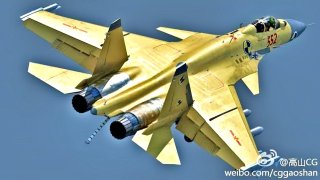China's J-15 Flying Shark Fighter Has a Ukraine Origin Story
According to reports, Beijing purchased an unfinished prototype of the Su-33 from Ukraine in order to reverse engineer it. The J-15 Flying Shark is essentially an unlicensed copy of the Russian jet.
Meet the J-15 Flying Shark: As tensions between Beijing and Washington continue to ramp up in the South China Sea, the U.S. Navy is taking a hard look at the PLAAF’s aerial abilities.
While the new Chengdu J-20 fifth-generation fighter would undoubtedly lead the PRC’s war strategy if kinetic conflict does erupt, China’s older airframes would also play a part.
The Shenyang J-15 fourth-generation fighter has been flying with the PLAAF for more than a decade now.
Over the last twenty years, Beijing and Moscow have worked to develop their own counters to America’s cutting edge and dominant platforms. The “Flying Shark” represents one of China’s more advanced airframes.
A Brief History of the F-15 Flying Shark
The origin story of the J-15 stems back to the early 2000’s, when Beijing unsuccessfully attempted to procure Russia’ Su-33 fighter on several occasions. Around this time, Moscow learned that China was developing a copycat airframe of its Sukhoi Su-27S fighter, a violation of intellectual property agreements.
For this reason, the Kremlin denied providing the PLA with its carrier-borne aircraft. However, Beijing continues to deny this accusation and instead asserts that the Su-33 deal fell through after Moscow demanded that it purchase 50 jets for a hefty price tag. China’s Shenyang Aircraft Corporation incorporated some of its own domestic engines and avionics into the Su-27 instead of using Russian components, which soured the relationship between the two countries.
The J-15 is a copycat of a Russian platform
According to reports, Beijing purchased an unfinished prototype of the Su-33 from Ukraine in order to reverse engineer it. The J-15 Flying Shark is essentially an unlicensed copy of the Russian jet.
Just as China previously designed its Shenyang J-11 as a copycat of the Soviet-era Su-27, the J-15 was also not domestically designed. In fact, the PRC has been accused of copying and reverse engineering several Russian weapons systems without permission, according to a 2017 report by the Stockholm International Peace Institute.
The J-15 initially entered service with the People’s Liberation Army Air Force in 2014. Nicknamed the “Flanker-X2” by the North Atlantic Treaty Organization (NATO), the J-15 remains a point of contention between Moscow and Beijing. Since the airframes introduction to the PLAAF, Russian-state news outlets have based the jet.
As detailed in a Business Insider piece, the Russian news outlet Sputnik reported that “The J-15 is too heavy to operate efficiently from carriers, has problems with its flight control systems, which has led to several crashes, and more,” adding that “Beijing doesn’t even have enough J-15s to outfit both of its carriers.”
Last November, footage revealed that the J-15 was finally fitted with China’s domestically produced WS-10 engines. Previously, the PLAAF’s fourth-generation fighters were powered by Russian AL-31F engines.
Beijing’s ability to move away from foreign components like the Russian engine suggests that China is becoming more confident in its manufacturing capabilities. The WS-10 has a troubled history, however, notably for its unreliable performance.

Despite this, the Chinese engine powers the country’s newer and more advanced Chengdu J-20 fifth-generation fighter jets.
If war between Beijing and Washington does ignite, China’s fleet of J-15 fighters would certainly play a key role in the country’s aerial strategy.
Maya Carlin is an analyst with the Center for Security Policy and a former Anna Sobol Levy Fellow at IDC Herzliya in Israel. She has by-lines in many publications, including The National Interest, Jerusalem Post, and Times of Israel. You can follow her on Twitter: @MayaCarlin.
All Images are Chinese Military Screenshots.


